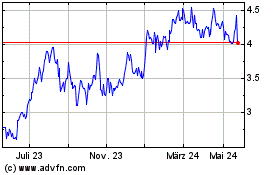Blackline Safety Unveils Whitepaper on Navigating Radiation Risks for Fire-Hazmat, Safety Workers
14 November 2024 - 1:17PM
Business Wire
Whitepaper provides critical insights to help companies,
individuals identify and assess threats to improve worker and
public safety
Blackline Safety Corp. (TSX: BLN), a global leader in connected
safety technology, has released a new whitepaper entitled
Navigating Radiation Risks: Key Concepts for Protecting Workers
and Responders in an effort to mitigate radiation exposure for
fire-hazmat and first responder teams.
Designed as a strategic playbook, the whitepaper aims to help
teams assess and react to the rising threat of radiation exposure
to better protect workers, the public and the environment.
“For those on the front line, such as first responders, hazmat
teams, and workers in industrial fields like mining and oil and
gas, there’s an increased risk of accidental exposure to dangerous
levels of radiation,” said Christine Gillies, Chief Product and
Marketing Officer at Blackline Safety. “Quick thinking and robust
emergency protocols are essential to ensure worker and community
safety.”
“This whitepaper responds to a growing industry need to educate
workers on the different types of radiation, early detection
strategies, and approaches to address the broad spectrum of
radiation risks, faster and smarter,” she said.
Key insights from the whitepaper:
- Radiation can be divided into four main categories: alpha,
beta, neutrons, and electromagnetic waves (or gamma rays), and
identified as non-ionizing or ionizing (nuclear) radiation and
particle or waveform. It’s important to understand the differences
to best respond to risks.
- There are two general categories where nuclear radiation can be
found: naturally occurring radioactive material (to which we’re
exposed simply by breathing the air around us or ingesting food and
water) and artificial sources (including medical imaging such as
X-rays and CT scans, nuclear energy and weapons, and dirty bombs),
and each has varying effects on the body.
- Radiation is measured differently in the U.S. than
internationally for the three forms of radiation measurement:
radioactivity, absorbed dose, and effective dose. The U.S. measures
radiation in millirems (mrem) per year, while most other countries
measure radiation in millisieverts (mSv) per year. Being familiar
with the different measurements enables workers to gauge overall
health effects.
- Gamma radiation cannot be detected through sight or taste.
Technology is needed to help determine its presence and develop
policies and procedures to deal with how gamma radiation levels are
monitored and what steps need to be taken in case of a radiation
emergency. There are several types of gamma radiation technologies
currently available, each with different uses, advantages, and
disadvantages.
- While our bodies can take in nominal levels of naturally
occurring gamma radiation from the surrounding environment, they
are not equipped to handle increased exposure levels without
incurring severe, life-long damage to our health. For those areas
where gamma radiation presents risks, radiation safety plans are
critical to ensure the three pillars of radiation protection –
time, distance, and shielding. The use of technology plays a key
role in worker and community safety, and area monitoring – such as
Blackline Safety’s newly-released EXO 8 Gamma, the only
direct-to-cloud area monitor capable of detecting up to eight gases
and gamma radiation – has been proven effective as one of the first
lines of defence.
Download the full whitepaper free of charge
here.
About Blackline Safety Blackline Safety is a technology
leader driving innovation in the industrial workforce through IoT
(Internet of Things). With connected safety devices and predictive
analytics, Blackline enables companies to drive towards zero safety
incidents and improved operational performance. Blackline provides
wearable devices, personal and area gas monitoring, cloud-connected
software and data analytics to meet demanding safety challenges and
enhance overall productivity for organizations with coverage in
more than 100 countries. Armed with cellular and satellite
connectivity, Blackline provides a lifeline to tens of thousands of
people, having reported over 250 billion data-points and initiated
over eight million emergency alerts. For more information, visit
BlacklineSafety.com and connect with us on Facebook, X (formerly
Twitter), LinkedIn and Instagram.
View source
version on businesswire.com: https://www.businesswire.com/news/home/20241114567925/en/
MEDIA CONTACT
Blackline Safety Robyn Chauvin, Director, Communications
rchauvin@blacklinesafety.com +1 403-441-0302
INVESTOR/ANALYST CONTACT
Blackline Safety Jason Zandberg, Director, Investor Relations
jzandberg@blacklinesafety.com +1 587-324-9184
Blackline Safety (TSX:BLN)
Historical Stock Chart
Von Dez 2024 bis Jan 2025

Blackline Safety (TSX:BLN)
Historical Stock Chart
Von Jan 2024 bis Jan 2025
